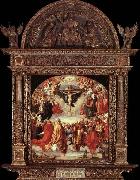La Peinture à l'huile en gros de Chine & Encadre |
|||||||||||

|
|||||||||||
|
|
|
||||||||||||||
|
Albrecht Durer
b.May 21, 1471, Imperial Free City of N??rnberg [Germany] d.April 6, 1528, N??rnberg |
||||||||||||||
|
|
||||||||||||||
|
||||||||||||||
|
|
||||||||||||||
| Albrecht Durer
b.May 21, 1471, Imperial Free City of N??rnberg [Germany] d.April 6, 1528, N??rnberg The_Adoration_of_the_Holy_Trinity 1511 Oil on lindenwood, 135 x 123,4 cm Kunsthistorisches Museum, Vienna This work was commissioned by the Nuremberg metal trader Matth?us Landauer. Also known as the Landauer Altarpiece, it was ordered for the chapel of the Twelve-Brothers House, which he endowed for a dozen impoverished artisans. In the centre of the painted panel at the top is the Trinity. God the Father is shown as emperor, holding Christ on the Cross and surmounted by the dove of the Holy Ghost. Around the figure of God are two rings of angels. Below them, to the right, are Old Testament figures and, to the left, followers of Christ bearing palm branches. Nearer the base of the picture are the slightly larger figures of the living, led by the Pope (with a blue tiara) and the Emperor (with a golden crown). The grey-haired figure of Matth?us Landauer, the donor, is depicted on the left, being welcomed into the throng by the outstretched hand of a cardinal. The landscape at the bottom of the panel stretches into the far distance. A lone figure stands on the land - the artist, who has depicted the earthly community being reunited with the realm of heaven. His hand rests on a panel which is inscribed: `Albrecht D?rer of Nuremberg made this 1511 years after the Virgin.' D?rer also designed an ornate frame for the altarpiece. An early drawing for the frame and panel is dated 1508 and shows that they were a carefully designed ensemble. The frame still survives in the Germanisches Nationalmuseum, Nuremberg, although unfortunately it has long been separated from the painting. (The frame shown in the reproduction is an exact replica of the original.) Made of carved and painted wood, the top of the frame has a sculpted depiction of the Last Judgement, with God enthroned and surrounded by the kneeling figures of the Virgin and John the Baptist. An inscription on the base of the frame records: `Matth?us Landauer has finally completed the house of worship of the Twelve Bretheren including the donation of this panel. After Christ's birth, the year 1511.' D?rer's workshop also designed stained-glass windows for the Twelve-Brothers Chapel, but these were removed in 1810 and were destroyed in Berlin during the Second World War.Artist:D?RER, Albrecht Title: The Adoration of the Holy Trinity (Landauer Altar) Painted in 1501-1550 , German - - painting : religious 1511 Oil on lindenwood, 135 x 123,4 cm Kunsthistorisches Museum, Vienna This work was commissioned by the Nuremberg metal trader Matth?us Landauer. Also known as the Landauer Altarpiece, it was ordered for the chapel of the Twelve-Brothers House, which he endowed for a dozen impoverished artisans. In the centre of the painted panel at the top is the Trinity. God the Father is shown as emperor, holding Christ on the Cross and surmounted by the dove of the Holy Ghost. Around the figure of God are two rings of angels. Below them, to the right, are Old Testament figures and, to the left, followers of Christ bearing palm branches. Nearer the base of the picture are the slightly larger figures of the living, led by the Pope (with a blue tiara) and the Emperor (with a golden crown). The grey-haired figure of Matth?us Landauer, the donor, is depicted on the left, being welcomed into the throng by the outstretched hand of a cardinal. The landscape at the bottom of the panel stretches into the far distance. A lone figure stands on the land - the artist, who has depicted the earthly community being reunited with the realm of heaven. His hand rests on a panel which is inscribed: `Albrecht D?rer of Nuremberg made this 1511 years after the Virgin.' D?rer also designed an ornate frame for the altarpiece. An early drawing for the frame and panel is dated 1508 and shows that they were a carefully designed ensemble. The frame still survives in the Germanisches Nationalmuseum, Nuremberg, although unfortunately it has long been separated from the painting. (The frame shown in the reproduction is an exact replica of the original.) Made of carved and painted wood, the top of the frame has a sculpted depiction of the Last Judgement, with God enthroned and surrounded by the kneeling figures of the Virgin and John the Baptist. An inscription on the base of the frame records: `Matth?us Landauer has finally completed the house of worship of the Twelve Bretheren including the donation of this panel. After Christ's birth, the year 1511.' D?rer's workshop also designed stained-glass windows for the Twelve-Brothers Chapel, but these were removed in 1810 and were destroyed in Berlin during the Second World War.Artist:D?RER, Albrecht Title: The Adoration of the Holy Trinity (Landauer Altar) Painted in 1501-1550 , German - - painting : religious |
||||||||||||||
|
Related Paintings to Albrecht Durer :. |
||||||||||||||
|
|
||||||||||||||
|
|
||||||||||||||
|
CONTACTER DES Etats-Unis |







